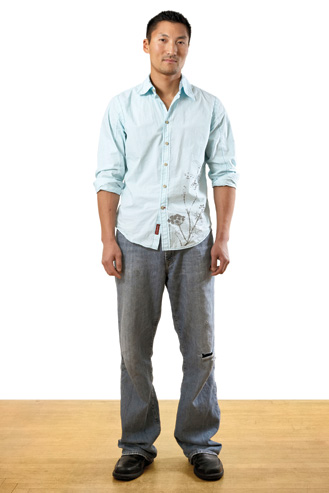We Are Kyopo
Visual artist Cindy Hwang a.k.a. CYJO brings the diversity that is Korean America into focus.
by Helin Jung
WHAT DOES BEING Korean American mean to you?
Do you know how to answer that question? Let’s think about it for a minute. Think about who you are, how you grew up, what kind of food you ate, the words you know, the superstitions you have, the names you’ve been called, the achievements you’ve made—are you any closer to knowing?
What does being Korean American mean to you?
It’s tough to articulate. Maybe because it speaks to the whole of who you are, maybe because it doesn’t. The best part is, the answer is different for everyone.
This is what visual artist Cindy Hwang a.k.a. CYJO discovered when she began The KYOPO Project, which she calls a “photographic and textual project on identity and immigration through the lens of the Korean diaspora.” It is a collection of 240 portraits of kyopo, or a person of Korean ancestry living outside of Korea.
The structure of each portrait is the same: The subject is standing on a blonde hardwood floor against a white background, staring into the lens with a straight face. Each looks different, but all are tied together by the uniformity of the setup. The project, now complete, has been released as a book, and will be featured in an exhibition of Asian American portraiture at the Smithsonian’s National Portrait Gallery, opening this month and running through Oct. 14, 2012.
The KYOPO Project began in 2004. After years of browsing the bookstore at New York City’s International Center for Photography, Hwang realized that, while there were photography books about weddings in Taiwan or street fashion in Japan, there were none that related to Korea.
“I was just really struck that there was nothing out there that folded in contemporary issues and Korean culture at the same time,” she says. “I literally woke up one Sunday and said, ‘I have to do this.’”
In November of 2004, she was standing in line at the Cooper-Hewitt Design Museum in New York when a man started talking to her. “He looked Korean to me, so I asked if he was Korean, and he said yes,” Hwang recalls. “This guy, who was random and accidental, is actually an M.I.T. professor in neurological and cognitive sciences, and runs his own lab.”
His name was Sebastian Seung, and he would be her first subject. Seung led her to her next subject, and the web kept growing, until what began as a 100-person series more than doubled in size. Her living room-cum-studio became a revolving door of Koreans: comedians, monks, actors, politicians, artists, adoptees, bankers and football players. The resulting book weighs more than eight pounds.
“It wasn’t about people I needed to get,” Hwang says, though there were a few good gets nonetheless. “It was about randomness and the organic nature of the process. It was literally to see what would surface.”

One of those subjects who surfaced was Yul Kwon, the lawyer-entrepreneur who also happens to have won the popular CBS reality show Survivor, worked for the federal government, and is now filming a television series for PBS.
Hwang had asked all her subjects to come dressed however they wanted to be seen, and that day, Kwon, who might be at his most recognizable when he’s unkempt and bare-chested, arrived in a pale blue button-up and jeans slightly torn at the knee. He had been doing regular speaking engagements for young audiences, and had wanted to look casual and relatable.
“The lens through which people see me depends on how they were first introduced to me, and differs radically depending on what I’m doing and what community I’m engaging with at the time,” Kwon says. “Cindy is trying to showcase the diversity of the kyopo community. There’s no one stereotype that applies to everybody, and in some ways, I’m living that.”

Another subject who defies stereotype is 55-year-old Esther Paik Goodhart, a stand-up comedienne who is the daughter of a Presbyterian minister, but teaches Hebrew and calls herself the Queen of the Jews. She was also born with dystonia, a neurological movement disorder. In her portrait, a cane in each hand, Goodhart stands tall and defiant.
“Yes, I am a Korean, and yes, I’m handicapped, and pretty much, my attitude toward people who don’t like it is, f-ck you,” Goodhart says. “I can be that nice, quiet Korean, but I’m also very proud of who I am, and America gives me the luxury to say what I want to say.”
While Hwang intended for the project to be open-ended, and her goal was simply to “see what would surface,” she found that, collectively, her subjects began to create a diverse and complex picture of Korean migration.

“[The book] does bring out such a variety of different types of mindsets and experiences,” she says. “A sense of globalness as well, which is fascinating.”
The discoveries didn’t necessarily bring Hwang a renewed sense of Koreanness; she had always carried that part of her identity comfortably. “I just feel more aware. When you feel more informed, you feel more grounded.”
For Goodhart, initially skeptical about the project when she first got word of it, the KYOPO endeavor lent her a sense of kinship.
“This was, to me, this unification of Korean people,” Goodhart says. “We’re like a salad of Koreans. We’re all in the same pot, but we’re all unique, we’re all individual.”
Several of the portraits featured in KYOPO will be shown at an exhibition in Washington, D.C., at the Smithsonian’s National Portrait Gallery titled “Potraiture Now, Asian in America: Portraits of Encounter,” running August 12 to Oct. 14, 2012.
This article appeared in the August 2011 issue of KoreAm.
[ad#bottomad]










